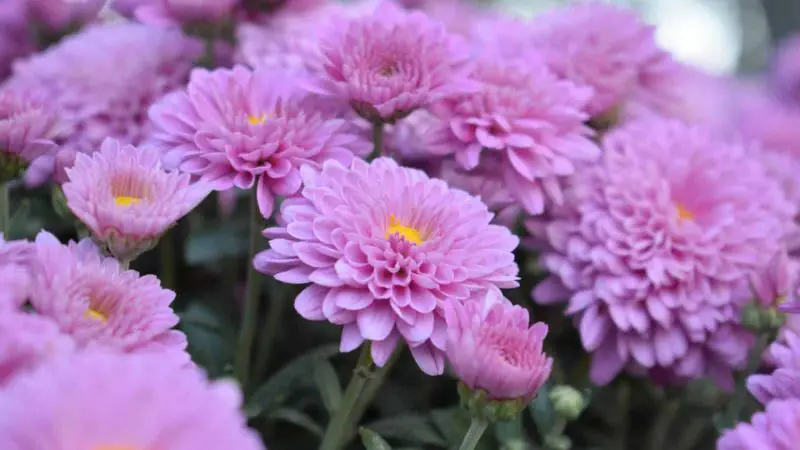Chrysanthemums, often called mums, are some of the most stunning flowers of the fall season. They fill gardens and patios with rich colors when most summer blooms fade away. Their shades range from golden yellows to deep reds and soft purples, creating a warm and cheerful autumn scene. Gardeners love mums for their variety, resilience, and ability to bloom when cooler weather arrives. However, to enjoy their best display, you need to understand their blooming habits.
Knowing when mums bloom helps you plan your garden and care routine effectively. These flowers respond strongly to daylight length and temperature changes. With proper timing and growing conditions, you can enjoy full, vibrant blooms that last for weeks. In this guide, you’ll learn when mums bloom, how to extend their flowering season, and what care steps help them thrive. Whether you grow hardy outdoor mums or decorative potted ones, mastering their bloom cycle is the key to a brilliant autumn garden.
Understanding When Mums Bloom

Mums are seasonal bloomers that follow natural cycles controlled by daylight and temperature. Unlike many flowering plants that bloom during long summer days, mums are known as short-day plants. This means they begin producing flower buds when nights grow longer and days shorten, usually in late summer. As daylight decreases to around ten to twelve hours per day, the plant’s internal clock triggers its flowering phase. In most regions, this happens between late August and early October, depending on the variety and local climate. Understanding this timing allows gardeners to plan their planting schedules for the best display.
The timing of mum blooms also depends on whether they are early-, mid-, or late-season varieties. Early-blooming mums can start showing color in late summer, while late-blooming types often wait until mid or late fall. Garden mums grown in cooler climates tend to bloom earlier because of shorter daylight periods and lower evening temperatures. In contrast, mums in warmer areas may take longer to bud and bloom since night temperatures remain higher. Knowing your local growing conditions helps you choose the best varieties to match your desired blooming time.
Healthy foliage growth before the blooming phase is essential for abundant flowers. Mums require full sun during their growing period to develop strong stems and plenty of leaves, which support future blooms. Once buds appear, consistent watering and moderate fertilization ensure large, long-lasting flowers. Keeping track of light exposure and temperature patterns helps you predict bloom time more accurately. By understanding how mums respond to changing seasons, you can create a garden that bursts into color just as summer ends and autumn begins, filling your space with vibrant, enduring beauty.
Different Types of Mums and Their Bloom Times
Not all mums bloom at the same time — their flowering schedule depends on the variety. Gardeners can enjoy color from midsummer to late fall by planting different types of mums with staggered bloom times. These variations are typically grouped into early-, mid-, and late-season bloomers. Early-season mums start blooming in late July or August, mid-season varieties follow in September, and late-season mums bloom from October into early November. Each type brings unique color, shape, and texture, creating continuous beauty throughout the changing seasons.
Early-blooming mums are perfect for gardeners who want to see color as summer transitions to fall. They thrive in regions with shorter summers and cooler nights. Popular early bloomers include cushion mums and single-flower varieties, which produce dense clusters of blooms that last several weeks. Mid-season mums are the most common type found in home gardens. They bloom right in the heart of autumn, often from late August through October, providing rich hues like bronze, orange, and burgundy. These varieties pair beautifully with pumpkins and fall décor, making them a seasonal favorite.
Late-season mums, often called “hardy mums,” bloom last but shine longest in cool weather. Their flowers open slowly and stay vibrant even after light frost. These mums are ideal for extending color well into November and can survive mild winters when planted early enough to establish strong roots. Choosing a mix of early, mid, and late bloomers ensures a garden that stays colorful for months instead of weeks. With thoughtful selection and care, mums can provide continuous waves of color from summer’s end through the heart of fall.
How to Choose the Right Mum Variety for Your Region
Selecting the right mum variety for your region is essential to achieving healthy growth, full blooms, and long-lasting color. Mums vary widely in their adaptability to different climates and growing conditions. In colder northern regions, hardy garden mums (Chrysanthemum morifolium) perform best. These perennials can survive winter if planted early, typically by mid-summer, allowing their roots to establish before frost arrives. They bloom earlier in the season and continue flowering even when temperatures drop. Their compact shape and frost tolerance make them perfect for borders, garden beds, and fall landscaping. Garden mums also handle fluctuating temperatures well, producing vibrant blooms year after year when cared for properly.
In southern or coastal climates where winters are mild and summers are hot, florist mums (Chrysanthemum × grandiflorum) or cushion mums thrive better. These varieties produce lush, large flowers and are often grown in containers or shaded garden spots. They prefer bright but indirect light and benefit from afternoon shade to avoid heat stress. Because warm regions often delay the natural blooming cycle, choosing late-season mums ensures that flowers open just in time for autumn displays. Regular watering and consistent light exposure help these varieties maintain color intensity and healthy foliage in hot weather.
When selecting mums for your garden, consider your USDA Hardiness Zone and local weather patterns. Early-, mid-, and late-blooming varieties allow you to enjoy color from late summer through the first frost. Mixing types that bloom at different times also guarantees a continuous display. Local nurseries often carry varieties suited for regional climates, so sourcing mums locally can improve success. With careful selection, your mums will not only bloom beautifully but also return stronger with each passing season, giving your garden reliable color and life.
Factors That Affect When Mums Bloom
Daylight Duration
Daylight duration is the single most critical factor in determining when mums bloom. These plants are short-day bloomers, meaning they start forming flower buds only after they experience longer nights and shorter days. As summer ends and daylight drops to around ten to twelve hours per day, mums receive the natural signal to begin flowering. This process, called photoperiodism, relies entirely on light exposure. If mums are planted near streetlights, porch lights, or other nighttime illumination, this artificial light can confuse the plant and delay blooming. Even brief light interruptions during the night may stop buds from forming altogether. For the most reliable results, plant mums in areas that receive full daylight but complete darkness at night.
Light consistency also affects bloom quality. Uneven light exposure can cause buds to develop irregularly, leading to partial flowering or weak stems. In temperate regions, where day length changes dramatically between seasons, mums bloom more predictably. Closer to the equator, where daylight hours remain more stable, blooming depends more on temperature than light. Still, maintaining a natural day-night rhythm is essential for healthy, timely blooms. By ensuring mums receive uninterrupted darkness during their critical pre-bloom phase, you help synchronize their flowering cycle perfectly with the changing season.
Temperature
Temperature plays an equally powerful role in shaping when and how mums bloom. These plants respond best to moderate conditions — warm days and cool nights. Ideal nighttime temperatures range between 50°F and 60°F (10°C–16°C). When temperatures drop within this range, mums shift from leaf production to flower bud formation. High daytime temperatures above 80°F (27°C) or warm nights over 70°F (21°C) can delay this process. The heat keeps the plant in its vegetative stage longer, resulting in lush foliage but fewer blooms. Once cooler evenings arrive, the flowering process accelerates, leading to tighter, more colorful buds that open gradually and last longer.
However, extreme temperature fluctuations can negatively affect bloom timing. A sudden cold snap before buds mature may damage or stop them from opening. Similarly, extended heatwaves can stress the plant, causing small, faded flowers. The best approach is to plant mums early enough in the season so they establish strong roots before cooler weather sets in. Consistent watering and mulching around the base can stabilize soil temperatures, helping mums adapt more smoothly. The balance between warm days and cool nights is the secret to perfect, long-lasting blooms that thrive well into the fall.
Water and Nutrition
Proper water and nutrition management are vital for predictable and vibrant mum blooms. Mums need consistently moist but well-draining soil to thrive. During their early growth phase, steady watering encourages strong roots and dense foliage, which sets the stage for abundant flowering. If the soil dries out completely, the plant becomes stressed, delaying bud formation. On the other hand, soggy soil leads to root rot, which weakens the plant and shortens the bloom cycle. Water deeply two to three times per week, depending on weather conditions, ensuring moisture reaches the root zone without pooling on the surface.
Nutrition also plays a major role in bloom timing and quality. Using too much nitrogen fertilizer results in lush green leaves but very few flowers. Instead, start with a balanced 10-10-10 fertilizer in early summer to support even growth, then switch to one higher in phosphorus once buds begin forming. Phosphorus promotes strong blooms with vivid colors and improved longevity. Feeding mums every two to three weeks during the growing season ensures they have the energy needed to flower right on schedule. When light, temperature, and nutrition align perfectly, mums reward you with dense, radiant blooms that define the beauty of fall gardens.
How to Encourage Mums to Bloom on Time
Getting mums to bloom right on schedule requires careful attention to their growing conditions throughout the season. The process begins with timing your planting correctly. For most regions, early spring to early summer is the ideal time to plant mums. This gives them several months to develop a strong root system and healthy foliage before the shorter days of late summer trigger blooming. Mums planted too late in the season may not establish properly, leading to weak or delayed blooms. Regular pinching during the early growing months also helps promote bushier growth and more flower buds. Removing the top inch or two of new growth every few weeks until mid-July prevents premature blooming and ensures the plant produces dense, even clusters of flowers in the fall.
Sunlight is another major factor in keeping mums on schedule. They need at least six hours of direct light daily during the growing period. Without enough sunlight, mums may produce fewer buds or bloom unevenly. For potted mums, rotating them weekly helps ensure all sides receive equal light exposure. In warm regions, providing afternoon shade during peak heat prevents stress and keeps the plant in balance. Watering also plays a critical role — mums should be kept evenly moist but never soggy. Consistent moisture supports healthy bud formation, while dryness at the wrong time can cause buds to stop developing.
Fertilization supports timely blooming as well. Begin feeding mums with a balanced fertilizer in spring and continue through mid-summer, but stop once buds begin to appear. Too much nitrogen after this stage delays blooming and promotes leaf growth instead of flowers. During late summer, reduce watering slightly to encourage the plant to shift energy toward opening buds. Finally, avoid artificial light exposure at night, as this can interrupt the natural short-day cycle that triggers blooms. By managing these simple but crucial factors, you can ensure your mums bloom right on time with brilliant color and full, lasting blossoms.
How to Extend the Blooming Season of Mums
Once mums begin to bloom, your goal shifts from triggering flowering to keeping those vibrant blossoms alive as long as possible. Extending the blooming season starts with location and light management. Mums thrive in bright, indirect sunlight during their flowering phase. While they need plenty of light, harsh afternoon sun can cause the petals to fade or dry out faster. Position your mums where they’ll receive gentle morning light and filtered shade later in the day. If you’re growing them in containers, it’s easy to move them as the season changes — giving them sun in cooler weeks and shade during warmer spells. This balance helps preserve flower color and prevents premature wilting.
Watering practices also make a significant difference. Mums in bloom need consistent moisture to keep flowers hydrated and healthy, but overwatering can cause buds to rot. Water at the base of the plant, keeping foliage dry, and always check the soil before watering again. During dry or windy conditions, increase watering slightly to prevent the flowers from drying out. Applying a thin layer of mulch around the base of the plant also helps retain soil moisture and keeps roots cool. If grown in containers, make sure excess water can drain freely. Stable moisture levels not only prolong bloom life but also encourage the plant to keep producing new flowers.
Deadheading — or removing spent flowers — is one of the simplest and most effective ways to extend the bloom period. Once a flower fades, snip it off just above a healthy leaf or bud. This encourages the plant to redirect energy into new blooms instead of seed production. Combining this with light fertilization using a phosphorus-rich formula supports ongoing flower growth. As the season cools, covering mums on chilly nights protects buds from early frost and extends their flowering window by several weeks. With consistent care, mums can remain vibrant from late summer well into November, filling your garden with enduring autumn color.
Caring for Mums After Blooming Ends
Fall Care: Preparing Mums for Dormancy
When the last blooms of autumn begin to fade, it’s time to shift focus from flowering to preservation. Fall is the most important season for post-bloom mum care, as proper maintenance ensures they return stronger the following year. Start by trimming off all spent flowers and removing any yellowing or damaged leaves. This keeps the plant tidy and prevents disease from spreading. However, avoid cutting mums all the way back immediately after blooming — their foliage still provides energy to the roots. Instead, allow the leaves to remain until a hard frost arrives. During this time, continue watering lightly every few days, keeping the soil slightly moist but never soggy. Healthy hydration helps mums store nutrients before entering winter dormancy.
As temperatures drop, add a thick layer of mulch or straw around the base of the plant. This insulates the roots and protects them from freeze damage. For potted mums, move containers to sheltered spots such as porches, garages, or greenhouses where temperatures stay above freezing. Avoid bringing them indoors to heated rooms, as warmth can disrupt their dormancy cycle. With proper care, mums will settle into a restful state, storing enough energy to regrow vigorously when spring returns.
Winter Care: Protecting Mums Through the Cold
Winter is a quiet yet critical time for mums. Most varieties go dormant during this season, conserving energy in their root systems. Outdoor mums benefit from extra protection during freezing weather. If you live in a region with harsh winters, cover your garden mums with pine branches, straw, or a breathable frost cloth to shield them from heavy frost and snow. For potted mums, avoid leaving them outdoors exposed to wind or freezing rain. Place them in a cool but frost-free area, such as a basement or enclosed porch, where temperatures remain between 32°F and 50°F (0°C–10°C).
During winter dormancy, mums require minimal watering. Too much moisture can cause root rot, so water only when the soil feels dry several inches below the surface. Avoid fertilizing during this period, as mums are not actively growing. The goal is simply to keep the roots alive without triggering premature growth. By keeping them cool, protected, and slightly moist, you ensure your mums survive the winter and are ready to wake up strong in spring.
Spring Care: Encouraging New Growth
As winter fades and temperatures rise, mums begin to show signs of life again. Early spring is the time to prune them back to about one inch above the soil line. This encourages fresh shoots to emerge and promotes bushier growth. Once new leaves appear, gradually remove mulch layers and start watering more frequently. Transplant or divide mums every two to three years to prevent overcrowding and maintain healthy blooming. Early fertilization with a balanced, slow-release formula jump-starts root and foliage growth for the new season.
Place your mums in full sunlight during spring to help them recover from dormancy and prepare for the upcoming bloom cycle. Regular pinching from late spring through midsummer ensures compact growth and more abundant flower clusters later. By nurturing your mums through each seasonal phase — protection in winter, pruning in spring, and preparation in fall — you set the stage for years of spectacular, vibrant blooms that light up every garden with enduring beauty.
How to Use Mums in Seasonal Garden Design
Mums are one of the most versatile plants in seasonal garden design, offering both structure and vibrant color during the transition from summer to fall. Their round shape and dense blooms create a natural focal point in any landscape. To design a stunning autumn display, combine mums with ornamental grasses, sedums, and asters. This mix enhances texture and creates a balanced palette of warm, earthy tones. Placing mums in repeating color patterns, such as alternating orange and yellow or red and white, gives a rhythmic flow to garden borders and walkways. These combinations not only elevate visual appeal but also help tie together different seasonal plantings for a cohesive design.
For container gardening, mums are perfect centerpiece plants. Their upright, compact growth pairs beautifully with trailing plants such as ivy, creeping jenny, or sweet potato vines. This creates an elegant cascading effect that adds depth to porches, patios, and balconies. You can also mix mums with cool-weather plants like ornamental kale, violas, and pansies for long-lasting fall arrangements. Choosing containers in rustic tones — like terracotta or bronze — enhances their seasonal warmth and complements autumn décor.
Mums transition beautifully indoors as well, bringing brightness to entryways and sunny windowsills. When moved inside before frost, potted mums can continue to bloom for several more weeks. Whether used as stand-alone accents or part of a layered garden layout, mums add seasonal charm that endures from late summer through early winter. By planning color combinations and placements thoughtfully, you can create a dynamic, evolving garden that celebrates every stage of fall with vivid beauty and timeless appeal.
FAQs About When Mums Bloom
When do mums usually start to bloom?
Most mums begin blooming in late summer and continue through the fall. Depending on the variety and local climate, early types can start as soon as August, while late-blooming mums often reach full color in October. Mums rely on shorter daylight hours and cooler temperatures to trigger their flowering cycle.
Why are my mums not blooming this year?
If your mums haven’t bloomed, they may be getting too much artificial light at night or not enough sunlight during the day. Mums need darkness to signal their bloom cycle. Overfertilization with nitrogen or planting too late in the season can also delay flowering. Make sure your mums receive at least six hours of sun daily and are planted before midsummer.
How long do mums bloom?
Most mums bloom for four to eight weeks, depending on the weather and care they receive. Cooler temperatures and consistent watering help flowers last longer. Deadheading — removing faded blooms — encourages new buds to form and can extend the blooming period well into late fall.
Do mums bloom more than once a year?
Mums typically bloom once a year, in the fall. However, if grown indoors under controlled lighting, they can be encouraged to bloom a second time. Outdoor mums rely on natural daylight cycles, so after their autumn bloom, they enter dormancy until the following year. Proper seasonal care ensures they return stronger.
What can I do to make mums bloom earlier?
To encourage early blooming, choose early-season varieties and ensure they receive plenty of full sunlight in spring and early summer. Avoid pruning after mid-July, as this can delay flowering. Gradually reduce fertilizer in late summer to help the plant shift from leafy growth to bud formation, promoting earlier blooms.
Conclusion
Knowing when mums bloom allows you to plan and care for them more effectively, ensuring a vibrant and colorful fall display. These resilient flowers respond naturally to shorter days and cooler nights, rewarding proper timing with abundant, long-lasting blooms. By understanding their light, temperature, and care needs, you can control their blooming cycle and even extend it well into late autumn. Whether you grow them in the ground or containers, mums bring warmth and beauty to every garden. With patience, seasonal care, and attention to detail, your mums will flourish year after year, marking each fall with radiant color and life.






